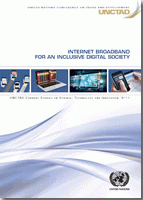
Internet broadband is shorthand for a range of capabilities enabled by the convergence of computers, the Internet, smart devices, high-speed wireline and wireless networks, and a plethora of innovative applications and services that these technologies make available.
Compared with narrowband technologies such as dial-up telephone connections, which deliver a maximum data rate of 56 kilobits per second (kbps), broadband Internet refers to high-speed public Internet access.
Although the boundary between narrowband and broadband is blurry, the International Telecommunication Union (ITU) describes broadband as Internet connections with downstream speeds of 256 kbps or more (ITU, 2010).
This study provides an overview of key issues relating to broadband ICTs in the context of international objectives for socioeconomic development.
The discussion summarizes recent research, policy developments and practices associated with broadband ICTs around the world and offers a set of frameworks for considering and developing new public and private initiatives to promote broadband development.
The study is organized into four sections.
Section 1 discusses the status and importance of broadband technology by examining the current broadband divide between developed and affluent segments of developing countries and the rest of developing countries, as the explosive growth of the broadband universe has not yet sufficiently penetrated the latter group of economies.
The section also reviews various ICT indicators across countries and discusses the potential benefits of broadband in invigorating economic development in countries and in improving social sciences, such as education, health care, and social and cultural services, as well as in facilitating the political engagement of the masses.
Section 2 introduces the current state of the broadband ecosystem. It describes how several layers of transmission networks, access facilities and end-user services are interconnected in the broadband infrastructure and summarizes recent developments in broadband technologies, end user devices, and software and applications.
In addition, section 2 describes the change in service providers in the sector – from State-owned enterprises to private suppliers in a competitive market.
Section 3 deals with key policy challenges and opportunities in the broadband sector. Many countries, particularly developing countries, are facing significant challenges on the expansion of its existing broadband infrastructure, such as high capital costs of investment, the lack of financial resources and hurdles relating to the spread of broadband services, for example lack of skilled personnel and digital content in local languages. Overcoming these issues requires an enabling and supportive public policy environment.
Section 4 provides a summary of the main findings and policy suggestions of the study.


